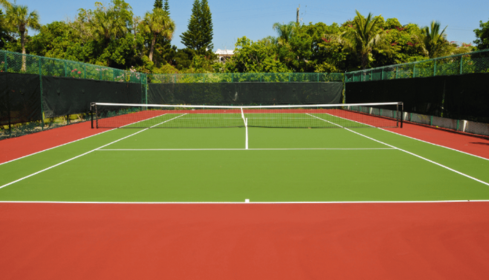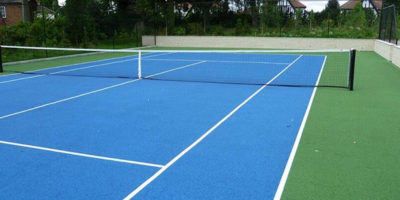Tennis is a game of speed, skill, and surface. Whether you’re a player, club owner, or a facility manager, understanding the tennis court surface coating, dimensions, and differences in surface types is essential for performance and maintenance. In this guide, we’ll break down the basics — from surface materials and coatings to tennis court surface paint and the actual surface area of a tennis court.
What Is a Tennis Court Surface Coating?
Tennis court surface coating refers to the top layer applied to the playing surface, which not only gives the court its final appearance but also directly affects bounce, grip, and player movement.
Most modern coatings are acrylic-based and are applied in multiple layers over concrete or asphalt bases. These coatings are essential for:
- Providing traction and slip resistance
- Enhancing ball bounce consistency
- Protecting the underlying structure from UV and weather damage
- Improving the visual appeal of the court
In addition to performance, a high-quality coating ensures durability, allowing the court to withstand constant use and harsh weather conditions.
Types of Tennis Court Surface Coatings
The tennis court surface plays a huge role in how the game is played. Let’s look at the most common types of coatings and how they differ:
1. Acrylic Hard Court Coating
- Most popular in schools, clubs, and international tournaments.
- Fast-paced game with a predictable bounce.
- Durable and low maintenance.
- Often used with cushioned systems for added comfort.
2. Clay Court Coating
- Slower surface; favors baseline players.
- Requires regular watering and brushing.
- Often used in European and South American countries.
3. Synthetic Turf with Sand Infill
- Suitable for multi-sport usage.
- Softer underfoot and good for recreational play.
- Lower maintenance than natural grass.
4. Carpet or Modular Tiles
- Easy to install and remove.
- Ideal for indoor or temporary setups.
These tennis court surface differences are crucial for selecting the right material based on location, budget, and playing level.
Choosing the Right Tennis Court Surface Paint
Tennis court surface paint is not just for aesthetics. The right paint contributes to traction, UV protection, and surface life.
Here’s what to look for in good quality surface paint:
- Non-slip texture: Reduces the risk of injury.
- UV resistance: Prevents color fading under the sun.
- Weatherproofing: Protects the surface from rain, moisture, and temperature changes.
- Vibrant color options: Common colors include green, blue, red, and purple, with white for line marking.
Acrylic-based paints are the industry standard. They bond well with asphalt or concrete and are environmentally friendly. For best results, two coats of paint are typically applied over the resurfacer layer.
Tennis Court Surface Area: Dimensions You Should Know
Whether you’re planning to build or paint a court, knowing the tennis court surface area is crucial.
So, how many square meters is a tennis court?
- Singles Court Dimensions:
23.77 meters (length) × 8.23 meters (width) = 195.65 m² - Doubles Court Dimensions:
23.77 meters (length) × 10.97 meters (width) = 260.87 m²
However, to allow for player movement and safe zones, a full-size tennis court with run-off space generally requires:
- 36.58 meters (length) × 18.29 meters (width) = 668.9 m²
This area includes room behind baselines and along sidelines for player safety.
Tip: Always plan resurfacing and painting based on total surface area including buffer zones — not just the playing lines.
Importance of Surface Area in Coating and Paint Estimation
When estimating how much tennis court surface coating or paint is required, the total square meters of your court (including buffer zones) determines your material quantity and cost.
- On average, a standard acrylic resurfacing system requires around 18–22 liters of paint per coat for a singles court and 25–30 liters for a doubles court.
- Two color coats and line marking are usually recommended.
- Always include wastage (5–10%) in calculations due to surface absorption and overcoating.
Tennis Court Surface Differences and Their Impact on Gameplay
Understanding tennis court surface differences is important for players and facility owners. Each surface alters the game speed, bounce, and physical demand.
| Surface Type | Speed | Bounce | Maintenance | Common Use |
| Hard (Acrylic) | Medium-Fast | High | Low | Schools, tournaments |
| Clay | Slow | High (but variable) | High | Europe, academies |
| Synthetic Grass | Medium | Medium | Medium | Recreational facilities |
| Carpet/Modular | Medium | Low | Very Low | Indoor, temporary courts |
These differences should guide your choice when building or resurfacing a court — especially in regions with specific climate challenges like India.
Maintenance Tips for a Long-Lasting Tennis Court Surface
To get the best performance from your tennis court surface, regular maintenance is key:
- Sweep regularly to remove dust and debris.
- Pressure wash the surface every 1–2 months.
- Repaint lines as they begin to fade.
- Inspect for cracks or low spots and repair early.
- Reapply tennis court surface coating every 4–6 years depending on usage.
Final Thoughts
Whether you’re planning to build a new court or maintain an existing one, understanding the nuances of tennis court surface coating, paint options, dimensions, and surface types is essential. Choosing the right tennis court surface paint enhances durability, aesthetics, and gameplay.
Knowing exactly how many square meters a tennis court covers helps you budget effectively and ensure proper resurfacing or construction. And by considering the tennis court surface differences, you can choose the ideal court for your environment and playing style.




